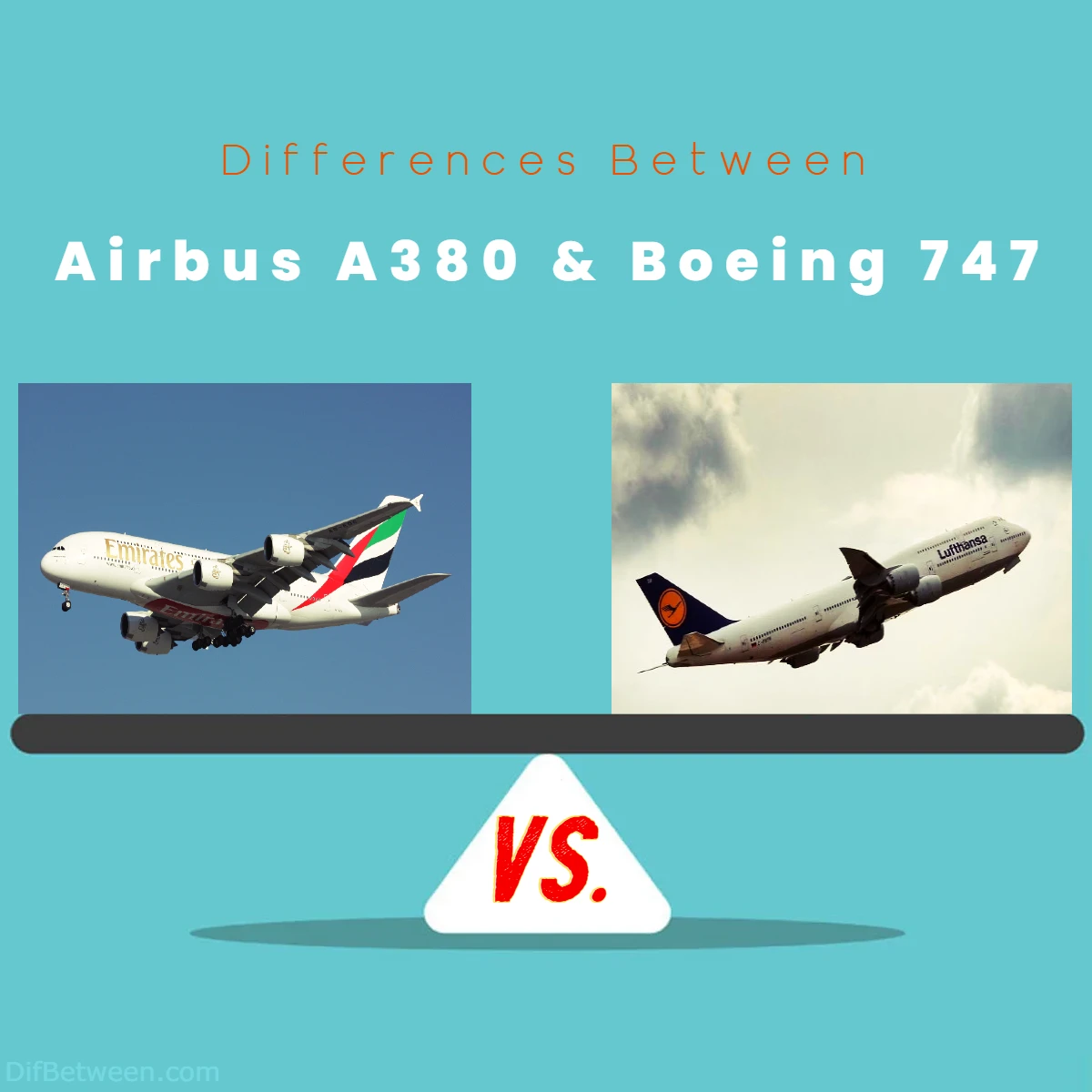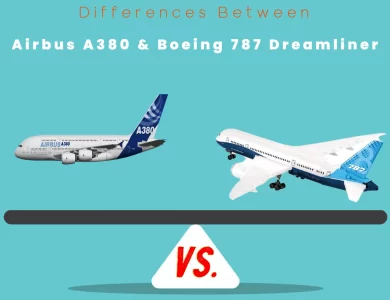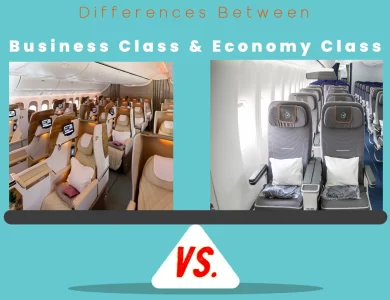
| Aspect | Airbus A380 | Boeing 747 |
|---|---|---|
| Design and Origins | European Consortium (Airbus) | American Aerospace Company (Boeing) |
| Capacity and Seating | 555 to 853 passengers | 366 to 524 passengers |
| Range and Long-Haul Capabilities | Approximately 8,000 nautical miles | 6,000 to 8,000 nautical miles |
| Fuel Efficiency and Environmental Impact | Modern, quieter engines, lower emissions | Continuous improvement in newer models |
| Technology and Innovation | Cutting-edge fly-by-wire technology Advanced in-flight entertainment | Time-tested technology with some modern updates |
| Configurations and Variants | Standardized design Two main variants: A380-800 and A380plus | Versatility with various models and adaptations |
| Production and Future | Production ceased in 2021 | Ongoing production for cargo variants |
When it comes to giants of the sky, the Airbus A380 and the Boeing 747 are two of the most iconic aircraft that have ever graced the heavens. These jumbo jets have been captivating aviation enthusiasts and travelers alike for decades. In this friendly and informative guide, we will delve into the key differences between these two aviation legends. From their design philosophies to capacity, let’s take a flight through the distinguishing aspects of the Airbus A380 and the Boeing 747.
Differences Between Airbus A380 and Boeing 747
The main differences between the Airbus A380 and Boeing 747 lie in their design origins, capacity, range, fuel efficiency, and production status. The Airbus A380, crafted by a European consortium, boasts colossal passenger capacity, accommodating between 555 to 853 travelers, and offers an extensive range of approximately 8,000 nautical miles. It incorporates modern technology and quieter engines for improved environmental sustainability. However, production of the A380 ceased in 2021. On the other hand, the Boeing 747, an American aerospace marvel, caters to a capacity range of 366 to 524 passengers, covering a similar long-haul range, and has a legacy of adaptability, versatility, and ongoing production, particularly for cargo variants. These distinctions highlight the varied strengths and applications of these two iconic aircraft.
Design and Origins
Airbus A380: The European Giant
The Airbus A380, often referred to as the “Superjumbo,” is a product of European aerospace ingenuity. This mammoth aircraft was designed and manufactured by Airbus, a consortium of European aerospace companies. The development of the A380 began in the late 1990s, with the aircraft’s maiden flight taking place in 2005. It was introduced into commercial service in 2007.
One of the most significant design features of the A380 is its twin-deck configuration throughout the length of the fuselage. This distinctive feature allows airlines to offer a spacious and comfortable cabin layout. The A380 is known for its advanced aerodynamics, impressive fuel efficiency, and quieter engines, making it an environmentally friendly choice for long-haul flights.
Boeing 747: The Original Jumbo Jet
The Boeing 747, often affectionately called the “Queen of the Skies,” has a legendary status in aviation history. Developed and produced by the American aerospace company Boeing, the 747 was the world’s first wide-body airliner. Its design dates back to the late 1960s when it was introduced as a revolutionary innovation in commercial aviation.
Unlike the A380, the Boeing 747 features a distinctive humpbacked design with a large upper deck, which is one of its defining characteristics. This upper deck provides additional seating capacity and has been used for various purposes, including lounges and even cockpit placement in some cargo versions of the aircraft. The 747’s original design was groundbreaking, setting the stage for future long-haul travel.
| Aspect | Airbus A380 | Boeing 747 |
|---|---|---|
| Design and Origins | European Consortium | American Aerospace |
| (Airbus) | Company (Boeing) |
Capacity and Seating
Airbus A380: Super Capacity
When it comes to passenger capacity, the Airbus A380 is an absolute giant in the world of commercial aviation. It can carry between 555 to 853 passengers, depending on the seating configuration chosen by the airline. The typical three-class seating arrangement includes first class, business class, and economy class, offering a range of options for passengers. Airlines often customize the cabin layout to cater to their specific market needs, making the A380 highly versatile.
The spacious interior of the A380 allows for larger seating areas, wider aisles, and even the possibility of amenities like onboard bars and lounges in some configurations. This aircraft is designed to provide passengers with a comfortable and enjoyable long-haul travel experience.
Boeing 747: Iconic Capacity
While the Boeing 747 doesn’t match the A380’s sheer passenger capacity, it is still an impressive aircraft in this regard. The 747 can typically carry between 366 to 524 passengers, depending on the specific model and configuration chosen by the airline. Like the A380, the 747 also offers various seating arrangements to accommodate different passenger classes.
The distinctive upper deck of the 747, located at the front of the aircraft, is a unique feature that sets it apart. This upper deck often houses premium cabins, providing passengers with a sense of exclusivity and luxury. While not as spacious as the A380, the 747 still offers a comfortable and enjoyable flying experience.
| Aspect | Airbus A380 | Boeing 747 |
|---|---|---|
| Capacity and Seating | 555 to 853 passengers | 366 to 524 passengers |
Range and Long-Haul Capabilities
Airbus A380: Global Reach
The Airbus A380 is designed for long-haul travel, making it an ideal choice for airlines operating on intercontinental routes. It has an impressive range of approximately 8,000 nautical miles (14,800 kilometers). This range allows it to cover routes such as New York to Hong Kong or London to Sydney with ease, making it a true global traveler.
The A380’s long-haul capabilities are complemented by its spacious cabin, which can accommodate passengers comfortably during extended flights. It’s a popular choice for airlines looking to transport large numbers of passengers across oceans and continents.
Boeing 747: Legendary Longevity
The Boeing 747 also boasts impressive long-haul capabilities. While the range of the 747 varies depending on the model and configuration, it generally falls in the range of 6,000 to 8,000 nautical miles (11,100 to 14,800 kilometers). This range allows it to serve a wide range of long-distance routes, connecting major cities across the globe.
One notable aspect of the 747’s long-haul history is its longevity in service. The aircraft has been flying for over five decades and has proven its reliability and adaptability over the years. Many 747s have been converted into cargo versions, extending their usefulness even further.
| Aspect | Airbus A380 | Boeing 747 |
|---|---|---|
| Range and Long-Haul | Approximately 8,000 | 6,000 to 8,000 nautical |
| Capabilities | nautical miles | miles |
Fuel Efficiency and Environmental Impact
Airbus A380: Eco-Friendly Engineering
One of the key focuses in the design of the Airbus A380 was fuel efficiency and reduced environmental impact. The A380 is equipped with modern, quieter engines that produce lower emissions compared to earlier aircraft models. It incorporates advanced aerodynamics and materials, all aimed at reducing fuel consumption and minimizing its carbon footprint.
The A380’s efficiency per passenger-kilometer is impressive, thanks to its massive capacity. While it may consume more fuel overall due to its size, it can distribute that consumption across a higher number of passengers, making it a relatively eco-friendly option for long-haul travel.
Boeing 747: A Legacy of Improvement
The Boeing 747, being an older design, may not match the A380 in terms of fuel efficiency and environmental features. However, Boeing has continuously worked on improving the 747’s engines and systems over the years to reduce its environmental impact. Newer versions of the 747, such as the 747-8, feature more efficient engines and updated technology, making them more environmentally friendly than older models.
It’s important to note that the 747’s efficiency may vary depending on the specific model and the modifications made by the airline.
| Aspect | Airbus A380 | Boeing 747 |
|---|---|---|
| Fuel Efficiency and | Modern, quieter engines | Continuous improvement |
| Environmental Impact | Lower emissions | in newer models |
Technology and Innovation
Airbus A380: Cutting-Edge Avionics
The Airbus A380 showcases cutting-edge avionics and technological innovations. Its cockpit features advanced fly-by-wire technology, which means that the pilot’s input is transmitted electronically to control surfaces rather than through traditional mechanical systems. This technology enhances flight control precision and reduces the workload on the flight crew.
Additionally, the A380 boasts impressive in-flight entertainment systems and connectivity options for passengers. Airlines have the flexibility to offer a wide range of entertainment options, including on-demand movies, games, and Wi-Fi, to keep passengers entertained during long journeys.
Boeing 747: Time-Tested Technology
The Boeing 747, although a technological marvel in its time, relies on older avionics technology compared to the A380. Over the years, Boeing has incorporated modern updates into the 747, but it may not match the A380’s level of sophistication in terms of electronic flight control systems.
In terms of passenger amenities, the 747 offers in-flight entertainment and connectivity options, but the range and quality of these systems can vary depending on the airline and the specific model of the aircraft.
| Aspect | Airbus A380 | Boeing 747 |
|---|---|---|
| Technology and | Cutting-edge fly-by- | Time-tested technology |
| Innovation | wire technology | with some modern updates |
Configurations and Variants
Airbus A380: Standardization
The Airbus A380 is known for its standardized design. While airlines have some flexibility in configuring the interior layout to suit their branding and passenger preferences, the overall design of the aircraft remains consistent. This uniformity makes it easier for airlines to maintain and operate A380s across their fleets.
The A380 also has two main variants: the A380-800 and the A380plus. The latter variant offers improved fuel efficiency and increased passenger capacity, but it has seen limited adoption.
Boeing 747: Versatility
The Boeing 747, over its long history, has seen a wide range of configurations and variants. From the original 747-100 to the more recent 747-8, Boeing has adapted the design to meet the changing needs of airlines. This versatility has allowed airlines to use the 747 for various purposes, including passenger flights, cargo transport, and even as Air Force One for the U.S. President.
The 747 family includes several variants, each with its unique features. For example, the 747-8 offers improved fuel efficiency and cargo capacity compared to earlier models. This adaptability has contributed to the 747’s enduring popularity.
| Aspect | Airbus A380 | Boeing 747 |
|---|---|---|
| Configurations and | Standardized design | Versatility with various |
| Variants | models and adaptations |
Production and Future
Airbus A380: Production Ceased
One significant difference between the A380 and the 747 is the status of their production lines. Airbus announced the cessation of A380 production in 2021 due to reduced demand for very large aircraft. While existing A380s continue to operate and serve passengers, no new units are being manufactured. Airlines are gradually retiring older A380s or converting them for cargo use.
Boeing 747: Ongoing Production for Cargo
Unlike the A380, the Boeing 747 is still in production, primarily for cargo versions. The 747-8 Freighter is a popular choice for cargo operators due to its large capacity and range. The cargo variant allows for the transportation of oversized and heavy cargo, making it a crucial part of the global cargo network.
Boeing’s decision to continue producing the 747 as a freighter demonstrates the enduring appeal of the 747’s design and its adaptability for various roles beyond passenger travel.
| Aspect | Airbus A380 | Boeing 747 |
|---|---|---|
| Production and | Production ceased in | Ongoing production for |
| Future | 2021 | cargo variants |
Airbus A380 or Boeing 747: Which One is Right Choose?
Choosing between the Airbus A380 and the Boeing 747 depends on various factors, including the airline’s specific needs, route network, passenger preferences, and long-term strategic goals. Let’s explore which aircraft might be the right choice under different circumstances:
- Passenger Capacity and Long-Haul Routes:
- If your airline operates high-capacity long-haul routes between major international hubs and aims to transport a large number of passengers efficiently, the Airbus A380 might be the better choice due to its massive seating capacity.
- Versatility and Adaptability:
- If your airline values versatility and adaptability, especially for cargo transport or different aircraft configurations, the Boeing 747 is the more suitable option. It has a history of successful adaptation to various roles beyond passenger travel.
- Fuel Efficiency and Environmental Considerations:
- If your airline places a strong emphasis on fuel efficiency and reducing environmental impact, the Airbus A380 may have the edge, as it incorporates modern, quieter engines and advanced aerodynamics designed to reduce emissions per passenger-kilometer.
- Technological Advancements:
- If your airline prioritizes the latest in avionics and passenger amenities, the Airbus A380 offers cutting-edge fly-by-wire technology and advanced in-flight entertainment systems.
- Production and Availability:
- Considering the production status, if your airline prefers an aircraft that is still in production and available for new acquisitions, the Boeing 747 is currently in production primarily for cargo variants.
- Historical Significance and Branding:
- If your airline wishes to leverage the historical significance and iconic status of an aircraft, the Boeing 747 with its “Queen of the Skies” nickname can be a valuable part of your branding.
- Market Demand and Passenger Experience:
- Assess the demand in your market and consider the passenger experience you want to provide. The spacious interior of the Airbus A380 may attract passengers looking for comfort and space, while the upper deck of the Boeing 747 can be tailored for premium cabins to offer an exclusive experience.
In conclusion, there’s no one-size-fits-all answer to the Airbus A380 vs. Boeing 747 question. Airlines must evaluate their specific operational requirements and market dynamics to determine which aircraft aligns best with their business objectives. Both aircraft have left a significant mark in aviation history, and their unique attributes can be leveraged to enhance an airline’s brand and service offerings.
FAQs
The primary difference between the Airbus A380 and Boeing 747 lies in their design origins, with the A380 being a product of a European consortium (Airbus) and the 747 originating from an American aerospace company (Boeing). Additionally, the A380 typically offers a higher passenger capacity and modern, quieter engines, while the 747 is known for its versatility and ongoing production for cargo variants.
The Airbus A380 generally has a higher passenger capacity, accommodating between 555 to 853 passengers, depending on the airline’s seating configuration. In contrast, the Boeing 747 typically carries between 366 to 524 passengers.
The Airbus A380 has an impressive range of approximately 8,000 nautical miles, making it suitable for intercontinental travel. The Boeing 747 also offers long-haul capabilities, with a range varying between 6,000 to 8,000 nautical miles depending on the specific model.
The Airbus A380 incorporates modern, quieter engines and advanced aerodynamics, making it more fuel-efficient and environmentally friendly in terms of lower emissions per passenger-kilometer. Boeing has continuously improved the environmental features of the 747, particularly in newer models, but it may not match the A380’s level of eco-friendliness.
No, the production of the Airbus A380 ceased in 2021 due to reduced demand for very large aircraft. Existing A380s continue to operate, but no new units are being manufactured.
Yes, the Boeing 747 is still in production, primarily for cargo variants such as the 747-8 Freighter. Boeing continues to produce these cargo versions to meet global cargo transportation needs.
The Boeing 747 is famous for its iconic upper deck, which is a distinctive feature of its design. This upper deck has been used for various purposes, including premium cabins and lounges in some configurations.
The Airbus A380 is often referred to as the “Superjumbo” due to its massive size and passenger capacity, making it one of the largest passenger aircraft in the world.
The Boeing 747 is affectionately known as the “Queen of the Skies” because of its historical significance and iconic status in the world of aviation.
The Airbus A380 offers a more standardized design, making it easier for airlines to maintain and operate across their fleets. While there is some flexibility in interior configurations, the overall design remains consistent.
Read More:
Contents






